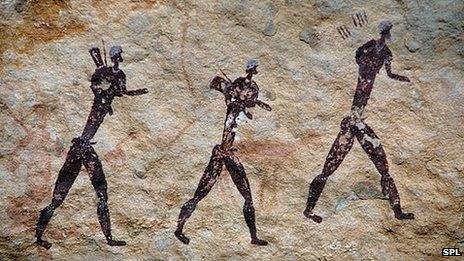Early humans' route out of Africa 'confirmed'
- Published

The study suggests early people crossed the Bab-el-Mandeb straits into Arabia
A six-year effort to map the genetic patterns of humankind appears to confirm that early people first left Africa by crossing into Arabia.
Ancestors of modern people in Europe, Asia and Oceania migrated along a southern route, not a northern route through Egypt as some had supposed.
The results from the Genographic Project are published in the journal Molecular Biology and Evolution, external.
It suggests an important role for South Asia in the peopling of the world.
The ancestors of present-day non-African people left their ancestral homeland some 70,000 years ago.
The researchers found that Indian populations had more genetic diversity - which gives an indication of the age of a population - than either Europeans or East Asians.
This supports the idea that pioneering settlers followed a southern coastal route as they populated east Asia and continued into Oceania.
"This suggests that other fields of research such as archaeology and anthropology should look for additional evidence on the migration route of early humans," said co-author Ajay Royyuru, senior manager at IBM's Computational Biology Center, which was involved in analysing the study data.
A route out of Africa via the Arabian Peninsula, along the southern coast of Asia, explained the observed patterns in genetic diversity much better than a route through Egypt's Sinai desert.
This agrees with other evidence showing that sea levels might have been low enough around 60-70,000 years ago for humans to cross from the horn of Africa into Arabia via the Bab-el-Mandeb straits in the Red Sea.
The latest findings are based on a new analytical method which exploits patterns of recombination in human genomes. Recombination is the process by which molecules of DNA are broken up and recombine to form new pairs.
The scientists used these patterns of recombination to trace relationships between different present-day humans.
"Almost 99% of the genetic makeup of an individual are layers of genetic imprints of the individual's many lineages. Our challenge was whether it was even feasible to tease apart these lineages to understand the commonalities," said IBM researcher Laxmi Parida.
"Through a determined approach of analytics and mathematical modelling, we undertook the intricate task of reconstructing the genetic history of a population. In doing so, we now have the tools to explore much more of the human genome."
Dr Spencer Wells, director of the Genographic Project, external, said such methods could provide "greater insights into the migratory history of our species".
Nearly 500,000 individuals have participated in the project, making it one of the biggest surveys of human genetic variation ever conducted.
The DNA was contributed by indigenous peoples and by members of the general public.
- Published23 September 2011
- Published10 November 2010
- Published22 December 2010